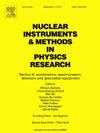用于高级环境监测的增强能量色散非弹性x射线散射
IF 1.5
3区 物理与天体物理
Q3 INSTRUMENTS & INSTRUMENTATION
Nuclear Instruments & Methods in Physics Research Section A-accelerators Spectrometers Detectors and Associated Equipment
Pub Date : 2025-04-09
DOI:10.1016/j.nima.2025.170519
引用次数: 0
摘要
评价一个给定元素的化学形态的一个有用的特征是使用谐振非弹性x射线散射(RIXS)对其环境的电子构型的依赖。这种方法提供的大量信息,加上高强度x射线源(如同步加速器或FELs)的进步,近年来推动了RIXS的显著增长。然而,将这种技术转移到传统实验室,虽然是可取的,但由于其发生的可能性低,这代表了一个主要的仪器挑战,这在研究重金属污染等特定应用中变得更加关键。事实上,在这些研究中,污染物浓度可能很低,需要样品激发的最大效率。在本工作中,我们分析了在能量色散构型(EDIXS)中使用x射线管作为激发源的可能性。为了提高实验装置的效率,使用了与所研究元素相同材料制成阳极的x射线管,并结合了选择源的特征Kβ线的单色仪。这条线通常具有稍低的能量,但非常接近产生它的元件的k边,从而高概率地诱导共振非弹性散射。提出的配置被用于分析铜,使用具有大接受立体角(12.5°孔径)的单色仪,该单色仪基于覆盖有18块扁平Si(100)晶体的对数螺旋剖面。该单色仪的制造和实现过程,特别是铜x射线管,在本工作中详细描述。使用该装置实现的EDIXS方法应用于一组无机铜化合物,以评估其对化学环境的敏感性,获得的结果与先前使用同步辐射报道的结果相似。最后,对该方法进行了测试,用于监测植物修复系统中水生植物吸收铜的化学状态,结果与先前的预测一致。所提出的方法为在传统实验室中实施RIXS提供了一种可行的替代方案,具有足够的灵敏度,可以分析浓度低至1% w/w的元素的化学状态,通常用于环境污染监测。本文章由计算机程序翻译,如有差异,请以英文原文为准。
Enhanced energy dispersive inelastic X-ray Scattering for advanced environmental monitoring
One of the useful characteristics for evaluating the chemical speciation of a given element is to use the dependence of Resonant Inelastic X-ray Scattering (RIXS) on the electronic configuration of its environment. The remarkable amount of information provided by this methodology, combined with advances in high-intensity X-ray sources such as synchrotrons or FELs, has driven significant growth in RIXS in recent years. However, transferring this technique to conventional laboratories, while desirable, represents a major instrumentation challenge due to its low probability of occurrence, which becomes even more critical in specific applications such as studying heavy metal contamination. Indeed, in these studies, contaminant concentrations can be low, requiring maximum efficiency in sample excitation.
In the present work, we analyzed the possibility of using an X-ray tube as an excitation source for RIXS in the energy-dispersive configuration (EDIXS). To increase the efficiency of the experimental setup, an X-ray tube with an anode made of the same material as the element under study was used, combined with a monochromator that selected the characteristic Kβ line of the source. This line generally has a slightly lower energy but is very close to the K-edge of the element that produces it, thereby inducing resonant inelastic scattering with high probability.
The proposed configuration was implemented to analyze copper, using a monochromator with a large acceptance solid angle (12.5° aperture) based on a logarithmic spiral profile covered with 18 pieces of flat Si(100) crystal. The manufacturing and implementation processes of this monochromator, specifically for a copper X-ray tube, are described in detail in this work. The proposed EDIXS methodology, implemented with this device, was applied to a set of inorganic copper compounds to evaluate sensitivity to the chemical environment, achieving results similar to those previously reported using synchrotron radiation. Finally, the methodology was tested for monitoring the chemical state of copper absorbed by aquatic plants in a phytoremediation system, yielding satisfactory results in agreement with previous predictions. The proposed methodology offers a viable alternative for implementing RIXS in conventional laboratories, with sufficient sensitivity to analyze the chemical state of elements at concentrations as low as 1 % w/w, typically found in environmental contamination monitoring.
求助全文
通过发布文献求助,成功后即可免费获取论文全文。
去求助
来源期刊
CiteScore
3.20
自引率
21.40%
发文量
787
审稿时长
1 months
期刊介绍:
Section A of Nuclear Instruments and Methods in Physics Research publishes papers on design, manufacturing and performance of scientific instruments with an emphasis on large scale facilities. This includes the development of particle accelerators, ion sources, beam transport systems and target arrangements as well as the use of secondary phenomena such as synchrotron radiation and free electron lasers. It also includes all types of instrumentation for the detection and spectrometry of radiations from high energy processes and nuclear decays, as well as instrumentation for experiments at nuclear reactors. Specialized electronics for nuclear and other types of spectrometry as well as computerization of measurements and control systems in this area also find their place in the A section.
Theoretical as well as experimental papers are accepted.

 求助内容:
求助内容: 应助结果提醒方式:
应助结果提醒方式:


